There is great diversity in the peonies plant genus. We introduce you to the most beautiful and most popular types of peonies.
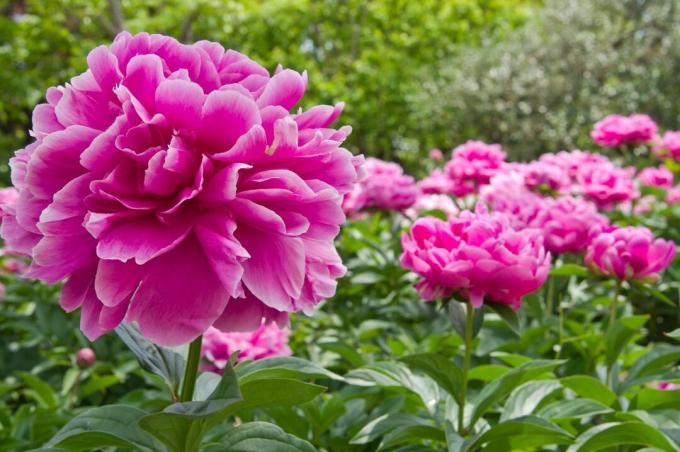
The genus of Peonies (Paeonia) has an almost unlimited variety of flower colors and shapes. This is thanks to the intensive and lengthy work of many plant breeders around the world. So it is almost difficult to name a favorite among the countless types and varieties of peonies. In order to make your decision a little easier, we present the most beautiful types of peonies below.
contents
- Peony species and varieties at a glance
- Different growth forms of the peony
- Choice of peony genus
- Peonies flowering times
-
Perennial Peonies
- Wild herbaceous peony species
- Historic herbaceous peony varieties
- Japanese peonies
-
Shrub peonies
- Wild shrub peony species
- Bush peonies: Paeonia suffruticosa
-
Peonies: hybrid varieties
- Herbaceous peony hybrids
- Tree peony hybrids
- Itoh hybrids: Intersectional peony hybrids
Peony species and varieties at a glance
Well-stocked horticultural companies offer up to 600 perennial peonies and up to 200 varieties of shrub peonies. With this immense number of plants, it is good to familiarize yourself with some of the distinguishing features.
Different growth forms of the peony
Within the genus Paeonia On the one hand the perennial peonies occur, on the other hand the shrub peonies. Both peony growth forms live up to their name: the non-woody shoots of the perennial peony die in autumn and sprout again in the next spring bursting with vigor. The bush peony, on the other hand, develops lignified shoots and does not move in during winter. As a result, the growth of the bush peony is usually essential under good conditions more expansive than that of the herbaceous peony, so that it provides a more generous space in the bed should be.
Choice of peony genus
The perennial peonies (especially Paeonia lactiflora) have a bulbous, thickened rhizome and herbaceous growth, that is, the plants sprout in spring, retreat back into the ground in autumn and survive there with the help of their wintering organs. The perennial peonies can reach a height of 130 cm and even grow beyond this with age. For this reason, sufficient space should be available from the outset.
The bush peonies (especially Paeonia suffruticosa) develop woody shoots and branches. Although they lose their leaves in autumn, they remain visible in the garden with their branch structures afterwards. This plant species can reach heights of 250 cm and more over many years if it is given a good location.
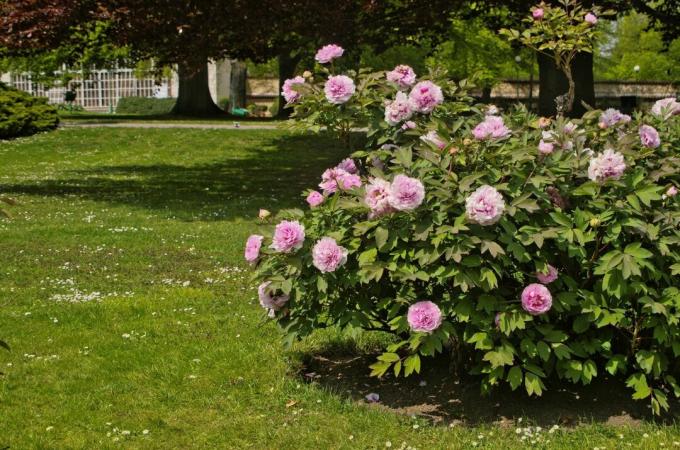
The peony hybrids are a little botanical sensation, as they are a cross between species of the perennial and shrub peony. This cultivated form has existed since the middle of the 20th century. Century thanks to the Japanese breeder Toichi Itoh, but has only been known in Germany for about two decades. Over time there were other breeds of this kind, so they now have a whole range of plants offer that bloom in different colors, grow very compact and have a particularly long flowering time to have. The hybrids only lignify at the base and often have very attractive foliage combined with the typical, rather compact growth for perennial peonies.
Peonies flowering times
In summary, the peonies bloom between mid-April and the end of June. The following portraits of the plants are intended to give you a first larger overview and at the same time the respective ones on a small scale Introduce individuals with their growth, their flowers and their other properties so that you can make the right choice at the plant dealer can.
The flowering times of the peonies in this article are broken down as follows:
- very early = between mid and late April
- early = between the end of April and mid-May
- middle = between mid and late May
- late = between the end of May and mid-June
- very late = Mid to late June
Perennial Peonies
Perennial peonies are among the most popular and robust plants in your own garden. They also like to stay in a location that suits their needs without having to be replanted more often afterwards. They are available in many color variations - with and without fragrance and with different heights. In the following paragraphs you will learn everything you need to know about the herbaceous peonies.
Wild herbaceous peony species
No other wild plant, apart from the shrub peony, develops flowers as large as the herbaceous peony. The colored calyxes of these individuals can grow up to 15 cm in size and have therefore earned a place in the sun. The home of the wild forms of the perennial peonies is on the slopes of the Caucasus, in the Urals, in the Himalayas and also in the Atlas Mountains in Algeria and Morocco. The European species are now almost extinct and can only be found in the southern parts of the Alps and in places in Siberia.
The following representatives of the wild peonies are particularly attractive:
- Wild peony (Paeonia officinalis): Reaches a height of 50 cm; white-pink flowers, 7 - 9 cm flower diameter, without fragrance; Flowering time is very early to early.
- Coral peony (Paeonia mascula subsp. arietina): Reaches a height of 60 cm; white-pink to carmine-red flowers, 10 - 12 cm flower diameter, without fragrance; Flowering time is very early to early.
- Greek peony (Paeonia peregrina): Reaches a height of 70-100 cm; red flower, flower diameter 7-11 cm, without fragrance; Flowering time is early.
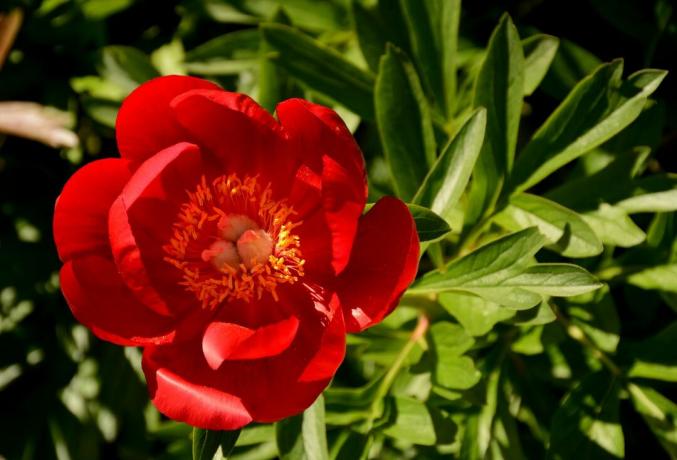
- Balkan peony, dill peony (Paeonia tenuifolia): Reaches a height of 30 - 40 cm; red flower, flower diameter 5 - 7 cm, delicate fragrance; Flowering time is very early.
- Yellow Caucasian Peony (Paeonia mlokosewitschii): Reaches a height of 50 cm; yellow flower, flower diameter 10 cm, delicate fragrance; Flowering time is very early.
- Chinese peony (Paeonia lactiflora): Reaches a height of 50 - 60 cm; white or pink flowers, 7 - 10 cm diameter, delicate fragrance; Flowering time is late.
Historic herbaceous peony varieties
This in the 19th and early 20th Peony varieties that emerged in the 19th century are no longer as present today as they were at that time. However, they are just as indispensable as the historical roses, which are still unrivaled in terms of their beauty and fragrance. Unfortunately, one disadvantage is the handling, as their flower stalks often cannot support the large flower head. Therefore, historical perennial peonies usually need a solid support. The majority of known and traded perennial peonies go to the species Paeonia lactiflora return.
The following varieties are particularly good in your own garden:
- ‚Duchesse de Nemours‘ (Paeonia lactiflora): Reaches a height of 80-100 cm; white flower, flower diameter 13 cm, fresh scent with lemon note; Flowering time is late.
- ‚Festiva Maxima‘ (Paeonia lactiflora): Reaches a height of 80 cm; white flower, flower diameter 12 cm, very good typical peony scent; Flowering time is medium.
- ‚Karl Rosenfield‘ (Paeonia lactiflora): Reaches a height of 70 cm; red flower, flower diameter 14 cm, delicate, spicy scent; Flowering time is medium.
- ‚Sarah Bernhardt‘ (Paeonia lactiflora): Reaches a height of 95 cm; pink flower, 16 - 20 cm flower diameter, strong fragrance; Flowering time is late.
- ‚Koenigswinter‘ (Paeonia lactiflora): Reaches a height of 65 cm; white-purple flower, flower diameter 14 cm, delicate fragrance; Flowering time is late with re-flowering.
- ‚Dwindles‘ (Paeonia lactiflora): Reaches a height of 95 cm; carmine-pink flower, flower diameter 14 cm, delicate fragrance; Flowering time is medium to late.
- ‚Wiesbaden‘ (Paeonia lactiflora): Reaches a height of 80 cm; pink nuanced flower, flower diameter 13 cm, without fragrance; Flowering time is late.

Japanese peonies
The plants in this group have their very own flower shape and were largely bred in Japan. The stamens of these varieties have been transformed into petals, ribbons or threads (petaloids) through cultivation and selection, which fill the interior of the flower. This peony flower was also known as the imperial flower in Japan. Another special feature is that the flower bowls often have a different color than the filling. Early 20th In the 19th century, this cultivated form also came to America, whereupon numerous American cultivars with the Japanese characteristics emerged within a short period of time.
The following varieties were particularly popular:
- ‚Bowl of Beauty‘ (Paeonia lactiflora): Reaches a height of 65 cm; dusky pink flower with light yellow filling, flower diameter 15 - 16 cm, without fragrance; Flowering time is late.
- ‚neon´ (Paeonia lactiflora): Reaches a height of 90 cm; pink-purple flower with red filling, flower diameter 12 cm, delicate fragrance; Flowering time is late.
- ‚Sword dance‘ (Paeonia lactiflora): Reaches a height of 70 cm; garnet-red flower with carmine-pink filling, flower diameter 14 cm, delicate fragrance; Flowering time is very late.
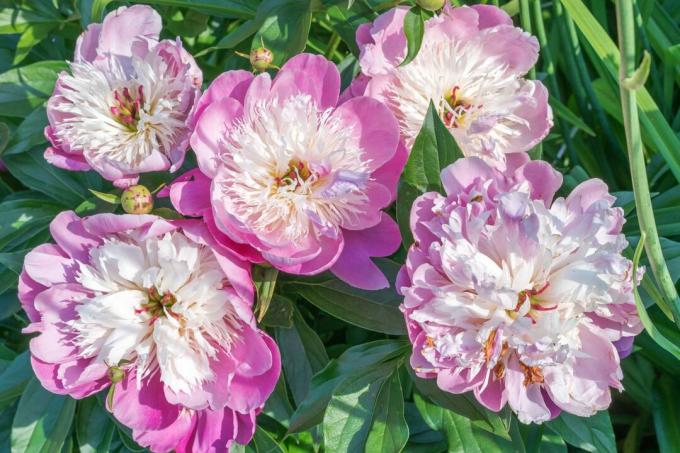
Shrub peonies
There are around 1,000 varieties of shrub peonies as well as a few different species that have a shrub-like habit. Most of the varieties of shrub peonies that are commercially available, however, belong to the species Paeonia suffruticosa. Central properties of the bush peonies are their often tall growth and their stable flower stalks.
Wild shrub peony species
The plants presented here are most relevant for today's cultivation of shrub peonies and have their natural home in China. They are commercially available as one to four year old seedlings.
- Paeonia rockii: Reaches a height of 150 - 200 cm; unfilled to double white or pink flowers with dark basal spots, up to approx. 20 cm in diameter, light fragrance; Flowering time is early; some maybe rather than Paeonia suffruticosa rockii known.
- Paeonia delavayi: Reaches a height of 150 - 200 cm; Mahogany-colored to orange-red flowers, up to 8 cm in diameter, lily scent.
- Paeonia ludlowii: Reaches a height of 180 - 250 cm; yellow flower with a diameter of 5 - 8 cm, without fragrance; Flowering time is late to very late.
- Paeonia lutea: Reaches a height of 100 cm; yellow flower with a diameter of 5 - 6 cm, lemon scent; Flowering time is late.
Bush peonies: Paeonia suffruticosa
With this variant, one can also speak of the historical bush peonies, as some varieties of this group are already several centuries old. Both the Chinese and Japanese as well as the old European varieties belong to this group. The tall growth and the light green to bright green leaves occur here in all peonies. Often times Paeonia suffruticosa-Hybrids, because the genetic identity of other peony species has already been incorporated, but the crossing partners can no longer be clearly identified.
The following plants enrich every private garden:
- ‚Hana Kisoi‘ (Paeonia x suffruticosa): Reaches a height of 150 - 200 cm; pink shaded flower, flower diameter 20 cm, fragrant; Flowering time is early.
- ‚Higurashi‘ (Paeonia x suffruticosa): Reaches a height of 130 cm; dark, dusky pink flowers, 16 - 18 cm diameter, without fragrance; Flowering time is early.
- ‚Shimadaijin‘ (Paeonia x suffruticosa): Reaches a height of 150 cm; red-purple flower, flower diameter 18 cm, without fragrance; Flowering time is early.

Peonies: hybrid varieties
Peony hybrids are the product of crossing two different ones Paeonia-Species. Depending on the genetic similarity, a cross between two different species can be more or less successful. In the case of peonies, combinations of varieties are different Paeonia-Species conceivable. In general, however, the goal is to combine the characteristics of the parents in the subsequent hybrid generation.
Herbaceous peony hybrids
The modern peony hybrids are usually characterized by a good stability and early flowering time compared to the historical, classic perennial peonies. The latter is usually four to six weeks before the for Lactiflora- Peonies usual beginning of flowering. Herbaceous peony hybrids come in many forms from white to pink to dark red and yellow and also with open, half-double or double flowers.
The following hybrids are particularly attractive:
- ‚Carina‘ (Paeonia x hybrida): Reaches a height of 70 cm; scarlet flower, flower diameter 14-17 cm, without fragrance; Flowering time is medium.
- ‚Coral charm‘ (Paeonia x hybrida): Reaches a height of 80 cm; coral pink flower, flower diameter 18 cm, without fragrance; Flowering time is medium.
- ‚Cytherea‘ (Paeonia lactiflora x Paeonia peregrina): Reaches a height of 50 cm; raspberry red flower, flower diameter 16 cm, without fragrance; Flowering time is early.
- ‚Paula Fay‘ (Paeonia x hybrida): Reaches a height of 50 cm; candy pink flower, flower diameter 12 cm, without fragrance; Flowering time is early.
- ‚Roselette‘ (Paeonia x hybrida): Reaches a height of 70 cm; pink flower, flower diameter 9 cm, delicate fragrance; Flowering time is early.
Tree peony hybrids
These hybrids arose from the cross between the noble ones SuffruticosaVarieties with the wild species Paeonia delavayi, Paeonia lutea and Paeonia rockii. The growth of these hybrids is about three weeks offset from the classic shrub peonies.
- ‚Black pirate‘ (Paeonia lutea x Paeonia delavayi): Reaches a height of 90 - 120 cm; dark red flower, flower diameter 15 cm, without fragrance; Flowering time is medium.
- ‚High noon‘ (Paeonia lutea x Paeonia delavayi): Reaches a height of 150 cm; yellow flower with red basal spots, flower diameter 10 cm, without fragrance; Flowering time is late.
- ‚Souvenir du Maxime Cornu‘(Also: 'Kinkaku', Paeonia suffruticosa x Paeonia lutea): Reaches a height of 150 cm; yellow flower with an orange border, 16 cm flower diameter, lovely scent; Flowering time is medium.
- ‚Tria‘ (Paeonia lutea x hybrid): Reaches a height of 150 cm; yellow flower, flower diameter 10 cm, lovely scent; Flowering time is early to medium.
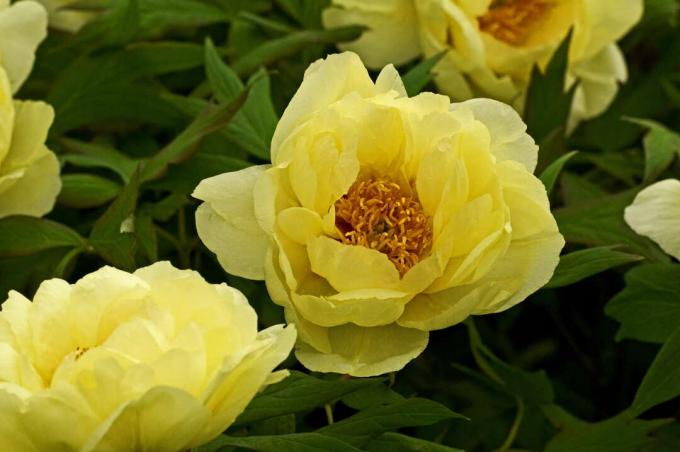
Tip: The later flowering time of these hybrids is suitable to extend the flowering time of the shrub peonies as a whole.
Itoh hybrids: Intersectional peony hybrids
The so-called Itoh peonies are a real specialty, namely hybrids between perennial and shrub peonies (Paeonia lactiflora x Paeonia lutea, Synonym: Paeonia x itoh). These intersectional crossings combine the evergreen and the flower size of the shrub peony with the compact growth and winter hardiness of the perennial forms. The crossings of the Itoh group were named in honor of their discoverer, the Japanese Toichi Itoh.
- 'Bartzella': Yellow Itoh hybrid with a red basal spot inside; maximum height of 100 cm; very popular, but also expensive.
- ‚Cora Louise‘: Cream-whitish with purple-colored eye; loose growth; reaches a height of 100 cm.
- ‚Love affair‘: Pure white flower; semi-double flower with late flowering period.
- ‚Old Rose Dandy‘: Changeable flower color from light beige to intense purple with all intermediate levels; semi-double flower; 70 to 80 cm in height.
- ‚Red double seedling‘: Intense dark red flower; partly filled with medium flowering time; up to 80 cm high.
- 'Scarlet Heaven': Red bright flower; maximum 80 cm high with a very bushy habit.
More about the right one Plant your peonies you can find out here in our special article.
